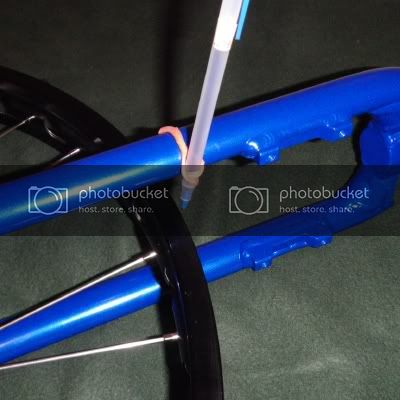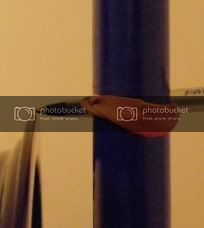i dont really want to take my wheel parts into my LBS to get it laced and trued and i thought it would be good for ne to learn how to do it. but i dont have a trueing stand or a dish stick. what can i do?
Super easy.
Do you have around 8 clamps? Use the frame as the stand, upside down, without the seat/post. Clamp it to something, and secure it: not to tight, you can damage the tubing. I have built around 10 wheels, and have used this method.
uhh
how about this… you get the wheel … where its bent… loosen the spokes that are on the side of the rim in the direction of the bend, and tighten the opposite spokes until your wheel is straight 
so i dont need a dish stick? how would it help anyway?
A dish stick will help measure whether the rim is centered. You can test for dish by turning the wheel around in your unicycle frame; the rim should be in the same place relative to the frame, whichever way you turn it. You don’t need a special tool.
so it pretty easy to get it true? how long until i have to re-true it?
A well-built wheel should stay true enough for most unicycling needs indefinitely, barring catastrophic failure. It is easy to get your wheel true; not so easy to build it well.
I built my Unicycle wheel on the Uni…
Built with used spokes, warped rim with flat spots in it, and a hub with a bent flange.
Belt the flange straight and laced up the wheel and spent an hour and a half truing it.
It’s now completely straight, but has flat spots in it still.
I haven’t trued it since the first time, and it’s been 2 months riding and it’s still fine.
Yeah I did sorta the same thing as danni. But mine had shitty nipples that stripped so it didn’t work all that great. but next rig I get i’m building/tuing the wheel.
[//EDIT//]w00t 400 posts[//EDIT//]
building it doesnt sound too hard just time consuming
correct? laceing isnt hard it just takes time?
Its not hard at all.
Some lacing combinations are tricky, but just read the isntructions slowly and understand them. Go one spoke at a time. =p
It can be tideous work, but I just started lacing my wheel 10mins ago. I am halfway done. =p
using a frame, elastic, and pen for truing stand.
Just built up a new wheel and figured I would share a pic of my “truing stand”
All you need is a frame, a pen, and an elastic


I used a 36" frame so the brake mounts would not get in the way but you could easily use the frame that goes with the wheel.
This is a really good idea. Why didn’t I think of that. I bought a maintenance stand to save my back. But putting two pens and securing them with rubber bands is something I never thought of.
Saskatchewanian seems to think of many things that the rest of us would never have thought of. 
Hooking a ziptie around the frame leg and using the uncut tail against the rim as an indicator works too. In time of monumental laziness, I’ve put my left thumb between the rim and the frame and used the width of the last knuckle as a gauge to find the wiggly spots, which was quite effective actually.
yep learn yourself, my lbs couldn’t do it on my 36er said its way to big for there truer machine.
That’s a good idea too. The problem I am having is that it’s hard to get the pens to extend the same amount from the frame. That’s important right? You can’t just judge by one “feeler” on one side…
Do you need to have two “feelers” at once?
And if the rim is pulling to the right, for instance, you would tighten the three spokes going to the opposite flange, with the center one closest to the apex of the pull? Do you then loosen the ones going to the right flange?
Sure you can, unless you’re supposing that the width of the rim isn’t the same everywhere. That shouldn’t be true for a new rim and would be a separate problem to deal with for a used one. The worst that might happen is you end up with a wheel that’s true but not quite perfectly centered, but it’s easy to fix that with a pass or two of loosening spokes on one side by some small amount and tightening spokes on the other side the same. And since frames are rarely perfectly symmetrical anyway…
In my non-pro experience there’s a bit of round-robin of getting the wheel pretty much round, pretty much centered, then pretty much true; and then really round, really centered, and really true. Or maybe true then centered if I notice that one is way off while working on the other. At some point it’s good enough. Unlike folks who do this for customers and dread ever seeing work come back into the shop, it’s easy for you or me to bust out the nipple wrench a month or two later and make it a little bit better then, so don’t make yourself crazy worrying too much about getting it just so.
Yes, tighten one side and loosen the other by the same amount so that you don’t pull it back out of round. (Dished wheels where the spokes on either side have different tensions complicate that a little.) I’ll adjust more than three spokes on each side if it’s a big wave rather than a little bump. But it’s always a smaller correction than what I think it needs to totally fix it. Make it somewhat better, check again to see what the biggest remaining problem is and try to make that one somewhat better, then repeat.
To piggyback on what LargeEddie said. Not only can you use only one feeler, but it is common practice even on the venerable Park TS-2. Just about every wheel builder I know who has had to work on that stand has used a screwdriver to hold one feeler away from the rim while working from one side. The so called “dishing” function of the ts2 is temporary when calibrated, and then only for a single OLD (over locknut dimension).
Also, as he said, you want to add tension to one side, and relieve the same amount of tension from the other side. So, if you tighten a spoke 1/2 turn you would loosen the adjacent spokes (other side) by 1/4 turn each. This keeps the concentricity true.